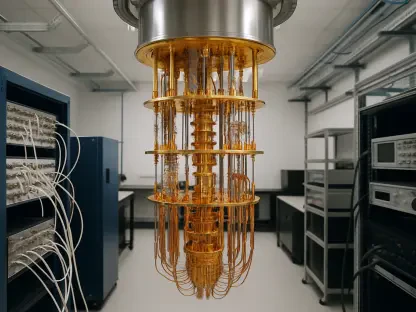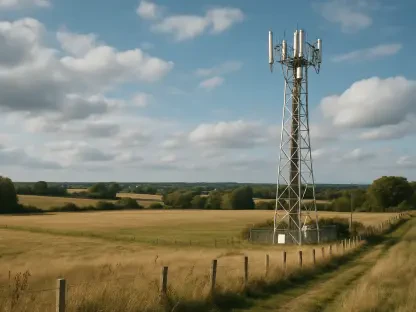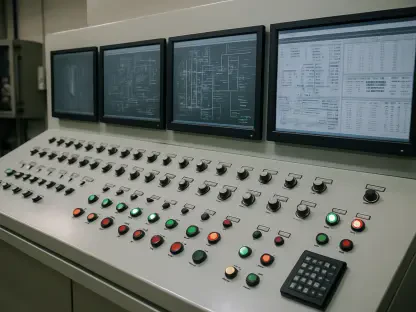In a world where technology is rapidly reshaping industries, portable 5G networks are emerging as a groundbreaking force in the realm of robotics, enabling machines to operate far beyond the boundaries of traditional infrastructure. Picture a remote disaster zone where robotic drones and ground units seamlessly coordinate rescue missions, or a sprawling rural farm where autonomous systems monitor soil health with pinpoint accuracy, all without the need for permanent network setups. These scenarios, once mere concepts, are now tangible realities thanks to deployable connectivity solutions. This innovation is dismantling long-standing barriers, allowing advanced robotics to thrive in isolated and temporary environments. From construction sites to emergency response operations, the impact is profound, promising not just technological advancement but also enhanced safety and economic viability. This exploration delves into how portable 5G networks are transforming robotic applications, unlocking potential across diverse sectors with unprecedented flexibility.
Overcoming the Connectivity Challenge
The evolution of robotics has long been hindered by the critical need for robust connectivity, a challenge that has confined advanced systems to urban and industrial areas with established 5G infrastructure. High-bandwidth data transmission, ultra-low latency, and unwavering reliability are non-negotiable for robots to perform complex tasks effectively. However, in remote regions like rural agricultural lands or transient construction sites, the financial burden of installing permanent networks often rendered robotic deployment impractical. This connectivity gap meant that transformative solutions, such as automated crop monitoring or remote machinery operation, remained out of reach for many who needed them most. The economic equation simply didn’t balance, as infrastructure costs frequently surpassed the immediate value of robotic intervention, leaving vast areas and critical applications underserved by cutting-edge technology.
Portable 5G networks have stepped in as a vital solution, shattering the historical constraints that tethered robotics to fixed telecommunications systems. These deployable networks deliver the necessary connectivity without the prohibitive expense of long-term infrastructure, making robotic operations feasible in previously inaccessible locales. The significance of this shift cannot be overstated—areas once excluded from automation due to geographic or financial limitations are now within reach. This breakthrough is not merely about extending coverage; it’s about democratizing access to advanced technology, ensuring that even temporary or remote projects can leverage the power of robotics. By providing a flexible alternative to permanent setups, portable networks are paving the way for broader adoption of automated solutions across industries, fundamentally altering the scope and scalability of robotic applications.
Unleashing Potential with Deployable 5G Solutions
The introduction of portable and private 5G networks marks a turning point for robotics, offering a lifeline to operations in environments where traditional connectivity falls short. These systems can be deployed swiftly for specific projects, delivering high-performance networking without the need for enduring infrastructure commitments. A compelling case is seen in Shetland, where BAM Nuttall implemented a private 5G network spanning over 55,000 square meters, enabling remote control of Boston Dynamics’ Spot robot for detailed laser scanning from hundreds of miles away. This example underscores the capability of temporary networks to rival fixed systems in reliability and efficiency. Such innovations are proving that robotics can thrive in isolated settings, opening up possibilities for automation in regions and scenarios previously deemed unfeasible due to connectivity constraints.
Beyond isolated successes, portable 5G networks are fostering a new paradigm of operational agility for robotic systems across varied landscapes. Unlike static infrastructure, these networks can be tailored to the unique demands of each deployment, whether supporting a short-term construction project or a rapid-response disaster mission. The ability to set up and dismantle connectivity solutions as needed eliminates the financial burden of permanent installations, making automation a viable option for smaller enterprises or transient operations. This adaptability ensures that industries can experiment with and integrate robotic technologies without the burden of long-term costs, thus accelerating the pace of innovation. As a result, the barriers to entry for leveraging robotics are significantly lowered, allowing a wider range of sectors to explore and benefit from automated processes in diverse and challenging environments.
Enhancing Precision through Technological Innovations
Portable 5G networks are not just about providing a connection; they are amplified by cutting-edge technologies that enhance robotic control and efficiency in remarkable ways. Edge computing plays a pivotal role by processing data locally, drastically reducing latency and minimizing bandwidth demands, which is crucial for real-time robotic operations. Meanwhile, network slicing allows for customized performance settings, enabling multiple robotic tasks to run simultaneously without interference. Innovations such as VR interfaces, pioneered at Heriot-Watt University’s National Robotarium, offer operators immersive control through headset visualizations and voice commands, making remote interaction with robots more intuitive. These advancements collectively ensure that robots can perform with greater precision, even in the most demanding and remote conditions, pushing the boundaries of what automation can achieve.
Another transformative development lies in sensory technologies that bridge the gap between human operators and robotic systems over portable 5G networks. Touchlab’s e-skin technology, for instance, equips robots with ultra-thin sensors that transmit tactile feedback in real time, allowing operators to “feel” through the machine. This capability is proving invaluable in fields like healthcare, where remote diagnostics require a delicate touch, and in hazardous industrial settings, where precision is paramount for safety. The integration of such sensory feedback with high-speed, reliable connectivity ensures that operators can execute complex tasks with a level of control previously unimaginable in remote setups. By combining these technological strides with deployable networks, robotics is evolving into a more responsive and versatile tool, capable of addressing intricate challenges across a spectrum of applications with unparalleled accuracy.
Redefining Industries with Tailored Applications
The versatility of portable 5G networks is vividly demonstrated through their impact on a variety of industries, each benefiting from tailored robotic applications enabled by deployable connectivity. In construction, these networks support remote operations in rugged, hard-to-reach terrains, enhancing both efficiency and worker safety. Agriculture, a sector worth £13.7 billion in the UK, sees autonomous robots monitoring crops and assessing soil over expansive areas with fewer base stations than Wi-Fi would require. Emergency response operations gain from networks that can be established within hours at disaster sites, coordinating diverse robotic units like drones and underwater rescue systems. Each of these applications showcases how portable connectivity is not a one-size-fits-all solution but a customizable framework that adapts to the specific needs of different fields, driving progress in unique ways.
Further expanding the scope, portable 5G networks are making significant inroads in healthcare and offshore energy maintenance, illustrating their adaptability to critical and high-stakes environments. In healthcare, tele-manipulation systems over 5G enable remote ultrasound examinations with haptic feedback, allowing medical professionals to diagnose patients from afar with precision. Meanwhile, in offshore wind maintenance—a vital industry for the UK with over 2,800 turbines—robotic solutions supported by portable networks are slashing fuel consumption by up to 90%, while also reducing risks to human workers in harsh marine conditions. These examples highlight the transformative power of combining robotics with deployable connectivity, as industries not only improve operational outcomes but also achieve substantial cost savings and safety enhancements. The ripple effects of such applications are reshaping economic models and operational strategies across these sectors.
Driving Economic and Operational Agility
One of the most compelling advantages of portable 5G networks in robotics is the economic and operational agility they introduce, fundamentally shifting how industries approach automation. Rather than committing to massive upfront investments in permanent infrastructure, businesses can now access project-specific connectivity that aligns with their immediate needs. This shift reduces financial risk, making robotic solutions accessible to smaller players or temporary initiatives that would otherwise be priced out. The flexibility to repurpose a single network across diverse applications—whether for construction, agricultural monitoring, or emergency response—creates innovative business models that prioritize adaptability. Such economic freedom is redefining the cost-benefit analysis of adopting robotics, encouraging wider experimentation and integration across various fields.
Reliability, a cornerstone of operational success, is another area where portable 5G networks deliver substantial benefits for robotic deployments. A notable instance is at the Port of Rotterdam, where private networks have eliminated the costly Wi-Fi failures that once disrupted autonomous vehicle operations in container terminals, with downtime expenses reaching up to €100,000 per hour. By ensuring consistent, high-performance connectivity, these networks prevent such interruptions, safeguarding productivity and minimizing financial losses. This reliability extends beyond port operations to other high-stakes environments, where uninterrupted robotic performance is critical. The ability to maintain seamless operations without the vulnerabilities of traditional connectivity options positions portable 5G as a cornerstone for future-proofing automation, ensuring that industries can rely on their robotic systems even under the most challenging conditions.
Navigating the Path to Widespread Adoption
While the potential of portable 5G networks to transform robotics is undeniable, scaling this technology to achieve widespread adoption presents notable challenges that must be addressed. Individual projects, such as the one in Shetland, have demonstrated the feasibility and effectiveness of deployable connectivity in isolated settings, yet the industry lacks standardized protocols for deployment that can streamline implementation across diverse scenarios. Modular equipment designed for rapid setup and teardown is also essential to maximize the practicality of temporary networks. Furthermore, comprehensive training programs for operators are needed to ensure that the workforce is equipped to handle the nuances of robotic systems supported by portable connectivity. Overcoming these hurdles is crucial to transitioning from isolated successes to a broader, more integrated application of this technology.
Collaboration stands as a linchpin for addressing the scaling challenges and unlocking the full potential of portable 5G networks in robotics. Bringing together robotics experts, telecommunications providers, and end-user industries is imperative to develop cohesive strategies that bridge technical and operational gaps. Such partnerships can drive the creation of unified standards, ensuring that deployable networks are interoperable and efficient across different sectors. Additionally, collaborative efforts can focus on innovating equipment design and enhancing training initiatives, preparing a skilled workforce to manage increasingly complex robotic tasks. As these collaborative frameworks take shape, the path to mainstream adoption becomes clearer, promising a future where portable connectivity empowers robotics to address global challenges with consistency and scale, reshaping industries in profound and lasting ways.
Reflecting on a Connected Robotic Legacy
Looking back, the journey of portable 5G networks in revolutionizing robotics revealed a remarkable shift in how automation was perceived and implemented across industries. What began as a solution to connectivity barriers in remote areas evolved into a catalyst for operational innovation, safety improvements, and economic accessibility. Projects like those in Shetland and the Port of Rotterdam showcased the tangible benefits, from seamless remote control to significant cost reductions, that defined this technological leap. The integration of advanced tools like edge computing and tactile feedback systems further elevated the precision and impact of robotic applications, leaving a lasting imprint on sectors ranging from agriculture to emergency response. As this era unfolded, the groundwork laid by deployable networks became a testament to technology’s power to transcend geographic and financial limits, forever changing the landscape of robotic possibilities.









